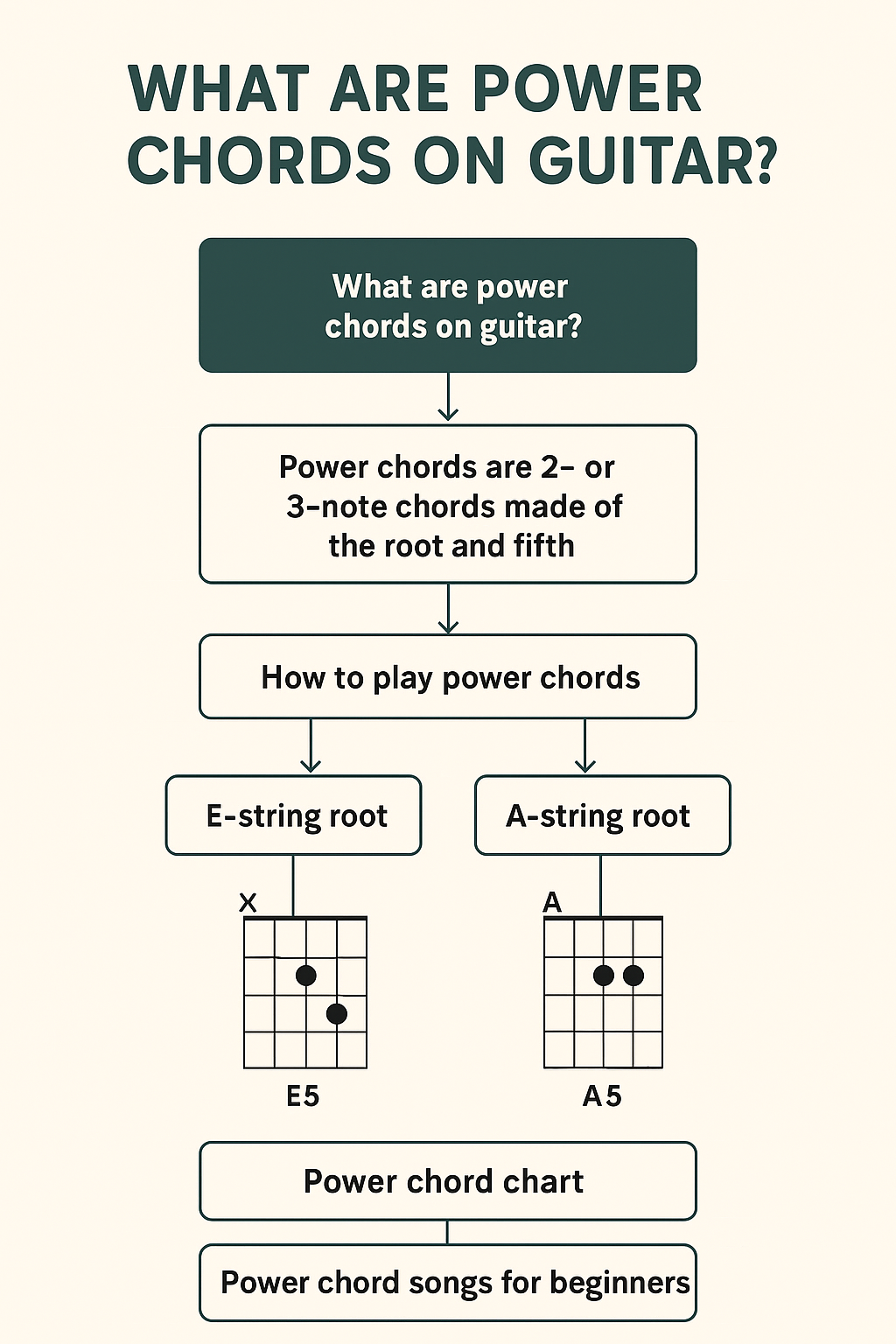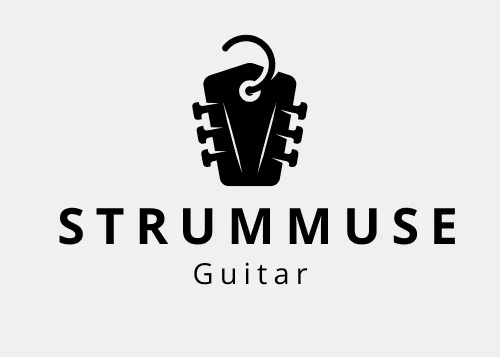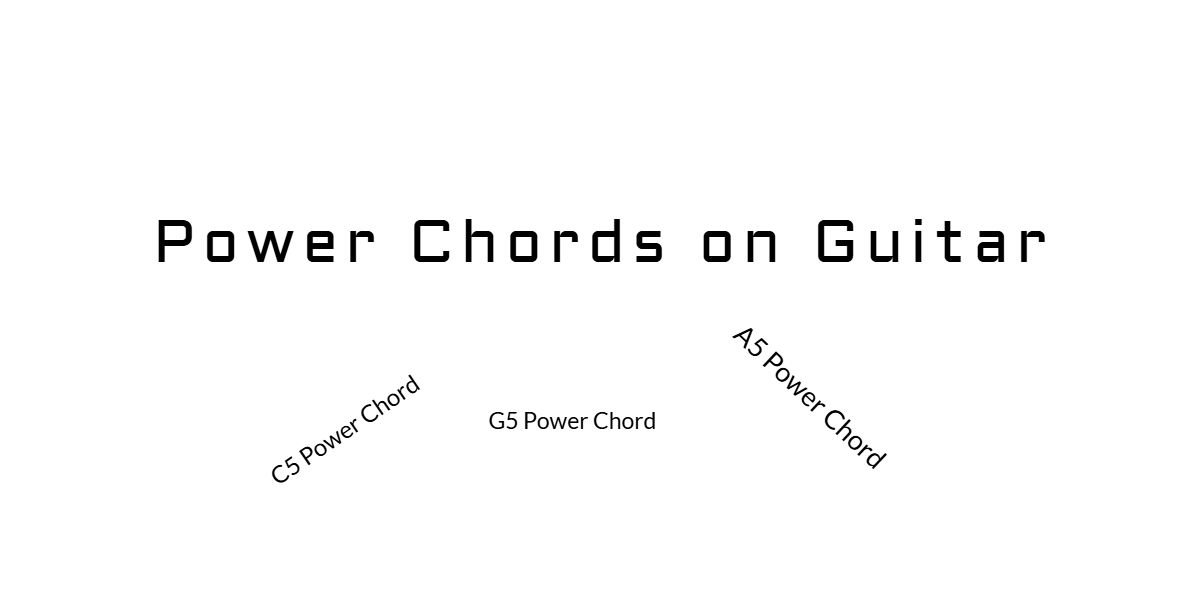Introduction
If you’ve ever listened to rock, punk, metal, or even pop music, you’ve definitely heard power chords in action. They’re punchy, aggressive, and surprisingly simple to play — which is why they’re one of the first things guitarists learn after open chords.
In this guide, we’ll break down what power chords are, how to play them, common shapes, theory, exercises, and songs so you can master them step by step. Whether you’re a beginner or looking to refine your technique, this post will cover everything you need.
What Are Power Chords on Guitar?
A power chord is a two- or three-note chord built from just the root note and the fifth of a scale. Unlike major or minor chords, power chords don’t have the third interval — which means they don’t sound specifically happy (major) or sad (minor). Instead, they have a neutral, powerful, and heavy tone.

👉 Formula: Root + 5th (+ Octave Root)
Example:
- A5 Power Chord = A (root) + E (fifth)
- E5 Power Chord = E (root) + B (fifth)
Because of this simplicity, power chords sound tight and clear, especially with distortion — perfect for rock and metal guitar.
Why Are They Called “Power” Chords?
They earned the name because they cut through a mix with strength and clarity. On an overdriven electric guitar, adding extra chord tones can sound muddy. But power chords, with only two or three notes, stay sharp and defined — giving that unmistakable rock punch.
How to Play Power Chords on Guitar
The Basic Shape (E-String Root)
Here’s the most common power chord shape:
- Place your index finger on the root note (6th string).
- Place your ring finger two frets up on the 5th string.
- Optionally, place your pinky on the 4th string, same fret as your ring finger (this doubles the root note an octave higher).
Example: G5 Power Chord
- 6th string, 3rd fret (G – root)
- 5th string, 5th fret (D – fifth)
- 4th string, 5th fret (G – octave root)
The A-String Root Shape
The same idea, but rooted on the 5th string:
Example: C5 Power Chord
- 5th string, 3rd fret (C – root)
- 4th string, 5th fret (G – fifth)
- 3rd string, 5th fret (C – octave root)
Power Chord Chart (Essential Shapes)
| Root Note | E String Shape | A String Shape | Chord Name |
|---|---|---|---|
| 1st fret | F5 | Bb5 | F / Bb |
| 3rd fret | G5 | C5 | G / C |
| 5th fret | A5 | D5 | A / D |
| 7th fret | B5 | E5 | B / E |
| 8th fret | C5 | F5 | C / F |
| 10th fret | D5 | G5 | D / G |
👉 Notice that the pattern is movable. You can shift the shape anywhere on the fretboard to get a new power chord.
How to Read Power Chord Tabs
A simple power chord riff in tab form looks like this:
E|----------------|
B|----------------|
G|----------------|
D|--5--7----------|
A|--5--7----------|
E|--3--5----------|
This shows a G5 to A5 to B5 progression — one of the most common rock riffs.
What Do Power Chords Sound Like?
- Neutral: Neither major nor minor.
- Heavy & Full: Perfect for distortion.
- Movable & Versatile: Can fit into almost any song.
Listen to songs by Nirvana, Green Day, Metallica, AC/DC — you’ll hear power chords everywhere.
Popular Songs That Use Power Chords (Demos for Practice)
Here are some classic power chord songs to learn:
- Nirvana – Smells Like Teen Spirit (F5 – Bb5 – Ab5 – Db5)
- Green Day – American Idiot (F5 – Bb5 – C5 – D5)
- Metallica – Enter Sandman (E5 riff-based)
- Deep Purple – Smoke on the Water (classic riff built from power chords)
- Blink-182 – All The Small Things
👉 These songs are great to practice switching between power chords smoothly.
Why Are Power Chords So Important?
- Easy to Learn: Just two or three fingers.
- Portable: Same shape, different positions = new chord.
- Rock Foundation: Essential for rhythm guitar in rock/punk/metal.
- Great for Beginners: No need to worry about major/minor at first.
Common Mistakes Beginners Make with Power Chords
- Playing too many strings → Mute unwanted strings with your index finger.
- Poor finger placement → Keep your fingers close to the frets.
- Tension in the hand → Relax your wrist for smoother transitions.
- Over-strumming → Only strum the strings that are part of the chord.
Also Check: The Biggest Mistakes I Made as a Beginner Guitarist (So You Don’t Have To)
How to Practice Power Chords (Exercises)
Exercise 1: Simple Movement
- Play E5 – G5 – A5 – C5 – D5 up and down.
- Focus on clean transitions.
Exercise 2: Rhythmic Muting
- Play E5 with downstrokes.
- Palm-mute slightly near the bridge for that chunky rock tone.
Exercise 3: Power Chord Riffs
Create mini riffs by moving shapes across the neck, e.g.,
E|------------------|
B|------------------|
G|------------------|
D|--2--5--7--9------|
A|--2--5--7--9------|
E|--0--3--5--7------|
Advanced Power Chords (Beyond the Basics)
Once you’re comfortable, you can try:
- Adding the octave root for a fuller sound.
- Inversions (playing fifth on the bottom).
- Sliding power chords for cool transitions.
- Palm-muted gallops (metal-style rhythms).
- Double stops for variation.
Power Chords on Acoustic vs. Electric
- Electric Guitar: Power chords shine with distortion/overdrive.
- Acoustic Guitar: Still usable, but they sound a bit empty compared to full chords.
Capo + Power Chords
Yes, you can use a capo with power chords. This allows you to keep familiar shapes but change the key easily — useful for acoustic or pop-rock styles.
FAQs on Power Chords
Q1: Are power chords real chords?
Technically, they’re called “dyads” (two notes), but in music culture, they’re widely accepted as chords.
Q2: Do power chords work in all genres?
They work best in rock, punk, grunge, and metal, but you can sneak them into pop and folk too.
Q3: Can I play power chords without distortion?
Yes — but they sound thinner on clean tone compared to distorted tone.
Q4: What’s the difference between a barre chord and a power chord?
A barre chord includes full major/minor chord tones, while a power chord is simpler (root + fifth).
Conclusion
Power chords are the backbone of rock guitar. They’re simple to learn, movable across the fretboard, and sound amazing with distortion. Whether you’re a beginner learning your first riffs or an advanced guitarist writing heavy rhythms, mastering power chords is a must.
👉 Start small, practice switching between shapes, and then learn classic power chord songs. Before long, you’ll be rocking out just like your guitar heroes.
💡 Next Steps for You:
- Try learning Smells Like Teen Spirit or American Idiot with power chords.
- Use a metronome to practice switching smoothly.
- Explore power chord charts to memorize shapes across the neck.


Excellent breakdown of the topic. Really appreciate the detail!